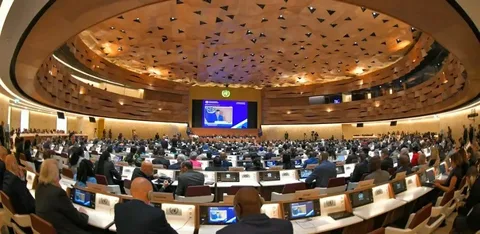ILO 2025 Achieves a major milestone in June 2025, when a very important decision was made at the 112th International Labour Conference (ILC) held in Geneva, Switzerland. The conference, organized by the International Labour Organization (ILO), adopted a new global standard to protect workers from biological hazards — such as viruses, bacteria, and other infectious agents that can make people sick at work.
ILO 2025 Achieves a Global Milestone in Health and Safety
This decision is being called a “landmark” — meaning one of the most important steps ever taken in the field of occupational health and safety. The new biological standards aim to make workplaces safer and healthier for millions of workers across the world.
In this blog, we’ll explore what this decision means, why it matters, and how it will help protect workers — in simple terms for both students and adults.
What Is the International Labour Conference?
ILO 2025 Achieves Global Unity Through the ILC
The International Labour Conference (ILC) is a yearly meeting organized by the International Labour Organization (ILO) — a UN agency that works to improve working conditions across the world.
At the ILC, representatives from:
- Governments
- Employers
- Workers’ unions
come together to discuss laws and policies related to jobs, workers’ rights, safety, and health.
ILO 2025 Achieves Focus on Biological Hazards
In 2025, the ILC focused on the growing concern about biological risks at work — especially after lessons learned during the COVID-19 pandemic.
Understanding Biological Hazards
What Are Biological Hazards?
Biological hazards (biohazards) are living organisms or substances produced by them that can harm humans. Examples include:
- Viruses (COVID-19, influenza, hepatitis)
- Bacteria (tuberculosis, cholera)
- Fungi (like black mold)
- Parasites (found in dirty water or uncooked food)
They can spread through air, water, blood, or contaminated surfaces, making people seriously ill.
Who Faces These Risks?
Many types of workers are exposed to biohazards daily:
- Doctors, nurses, lab technicians
- Sanitation and waste workers
- Farmers and animal handlers
- Food processing workers
- School teachers and janitors
- Public transport staff
These hazards are not limited to pandemics — they are a daily threat.
What Do the New Biological Standards Say?
ILO 2025 Achieves Safer Work Environments with Key Protections
The ILC adopted a new Convention and Recommendation on biological hazards. These provide clear and specific rules to protect workers. Here’s what they include:
H3: 1. Risk Assessment
Employers must:
- Identify all possible biological risks
- Check if a virus or bacteria is present
- Evaluate if cleaning, waste handling, or air quality is safe
H3: 2. Preventive Measures
Once risks are known, employers must take safety actions:
- Install proper ventilation
- Ensure regular cleaning and disinfecting
- Offer vaccination programs
- Use safe waste disposal methods
H3: 3. Use of Personal Protective Equipment (PPE)
Employers must give workers:
- Masks
- Gloves
- Face shields
- Protective clothing
And they must train workers on how to use PPE correctly.
H3: 4. Training and Education
All workers (even temporary ones) must be taught:
- How biohazards spread
- How to stay safe
- What to do if exposed
H3: 5. Medical Support and Reporting
If a worker is exposed:
- They must get immediate medical help
- The case must be reported
- The workplace must be inspected and improved
H3: 6. Emergency Preparedness
Workplaces must have emergency plans for:
- Sudden outbreaks (like COVID-19)
- Accidental exposures
- Mass infections
This includes regular drills and response teams.
Why Are These Standards So Important?
H3: ILO 2025 Achieves Stronger Defenses Post-COVID
The COVID-19 pandemic exposed weaknesses in worker safety. Many people:
- Had no protective gear
- Weren’t trained
- Got sick and spread infections
These standards aim to fix those gaps and protect workers everywhere.
Global Impact of the New Standards
ILO 2025 Achieves Protection for Millions of Workers
These new rules:
- Can save lives
- Protect low-income and frontline workers
- Improve public health
- Build resilient workplaces for future health threats
Which Countries Will Follow the Standards?
ILO 2025 Achieves Worldwide Collaboration
The ILO has 187 member countries, including India. Each country can choose to ratify (officially accept) the new rules.
If they do, they must:
- Pass national laws
- Train employers and workers
- Inspect and monitor workplaces
- Offer free protective gear and medical help
The ILO will also support countries with funding, training, and resources.
A Simple Example for Students
Let’s say a school janitor is cleaning during flu season. If he doesn’t have gloves or a mask, he might get sick. But if the school gives him the right tools and training, he stays safe.
Now imagine this happening in millions of schools, hospitals, and offices. That’s the impact of the ILO’s new standards.
What Happens Next?
ILO 2025 Achieves the First Step — Now the World Must Follow
Now that the rules are adopted:
- Countries must decide to ratify
- The ILO will monitor progress
- Reports will be shared publicly
- New worker safety laws will follow
It may take time, but this is a historic beginning.
Conclusion: ILO 2025 Achieves a Safer Future for All
The adoption of the Biological Hazards Convention and Recommendation by the International Labour Conference is a major victory for worker safety. It sends a clear message:
Every worker deserves protection from invisible threats like viruses and bacteria.
These standards will protect workers every day — not just during pandemics. Whether you’re a student learning about the world of work, or an adult going to your job each day, this change matters. When workers are protected, families, communities, and entire nations grow stronger and healthier.



